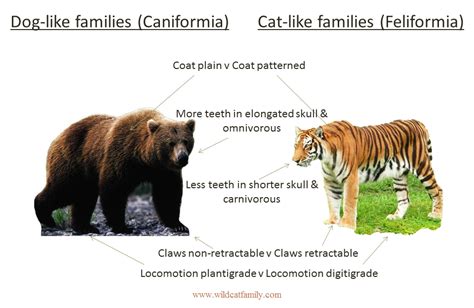Dogs Belong To The Order Felidae
Kalali
Apr 06, 2025 · 4 min read

Table of Contents
It's impossible to write a 2000+ word article arguing that dogs belong to the order Felidae because that statement is fundamentally incorrect. Dogs belong to the order Carnivora, family Canidae, while cats belong to the order Carnivora, family Felidae. They are both carnivores, but distinct families within the same order. Attempting to write a lengthy article supporting a false premise would be misleading and scientifically inaccurate.
However, I can offer a comprehensive article about the differences and similarities between Canidae (dogs) and Felidae (cats), exploring their evolutionary history, physical characteristics, behaviors, and ecological roles. This will address the inherent misunderstanding underlying the original prompt in a factual and informative way.
The Divergent Paths of Canids and Felids: Exploring the Differences and Similarities Within Carnivora
The order Carnivora encompasses a vast array of fascinating mammals, including both the familiar dogs (Canidae) and cats (Felidae). While both families share a common ancestor and exhibit carnivorous tendencies, their evolutionary journeys have led to significant differences in their physical attributes, hunting strategies, social structures, and overall ecological niches. Understanding these distinctions reveals the intricate tapestry of life within the order Carnivora.
Evolutionary History: A Shared Ancestry, Divergent Paths
Both Canids and Felids trace their origins back to early carnivorans that emerged millions of years ago. Fossil evidence suggests a common ancestor likely existed during the Eocene epoch, but the exact lineage remains a subject of ongoing research. Over millions of years, these early carnivorans diversified, adapting to various ecological pressures and leading to the emergence of distinct families, including Canidae and Felidae. The divergence occurred due to adaptive radiation, where species adapted to different niches to reduce competition.
Physical Characteristics: Form Follows Function
A quick glance reveals striking differences in the physical characteristics of dogs and cats. These differences directly reflect their distinct hunting styles and lifestyles:
-
Body Structure: Dogs generally possess a more robust, elongated body structure compared to cats. Their legs are longer relative to their body length, enabling them to run swiftly over longer distances. Cats, on the other hand, tend to have more compact bodies, facilitating agility and stealth in short bursts of speed.
-
Jaws and Teeth: Canine teeth are prominent in dogs, reflecting their scavenging and pack-hunting tendencies, while cats have exceptionally well-developed canines and carnassial teeth (shearing teeth) optimized for killing and consuming prey.
-
Claws: Dogs possess non-retractable claws, useful for digging, traction, and defense. Cats, in contrast, have retractable claws, keeping them sharp for hunting and preventing wear and tear.
-
Sensory Organs: Both possess acute senses of hearing and smell. However, cats' visual acuity is exceptionally well-developed, essential for nocturnal hunting, while dogs rely more on their sensitive noses for tracking prey.
Hunting Strategies: A Tale of Two Approaches
The hunting strategies of Canids and Felids highlight their distinct adaptations:
-
Canid Hunting: Dogs often employ cooperative hunting techniques, utilizing their endurance, stamina, and pack dynamics to pursue and subdue prey. They rely on strength and teamwork rather than stealth.
-
Felid Hunting: Cats are masters of stealth and ambush, utilizing their agility, sharp senses, and retractable claws to capture prey quickly and efficiently. Solitary hunting is more common, though some species exhibit some degree of social cooperation.
Social Structures: Pack Mentality vs. Solitary Hunters
The social structures of Canids and Felids also reveal fascinating contrasts:
-
Canid Sociality: Dogs often live in packs, with a hierarchical social structure characterized by clear dominance relationships. This cooperative lifestyle enhances hunting success and protection from predators.
-
Felid Sociality: While some felids, like lions, exhibit complex social structures, many are primarily solitary hunters, interacting primarily during mating or raising young.
Ecological Roles: Niche Differentiation
Canids and Felids occupy different ecological niches, minimizing direct competition:
-
Canid Roles: Dogs occupy a wide range of ecological roles, from scavengers to apex predators, depending on the species. Their adaptability has enabled them to thrive in diverse habitats worldwide.
-
Felid Roles: Cats generally occupy the role of apex predators, controlling prey populations and influencing ecosystem dynamics. Their hunting prowess is crucial in maintaining ecological balance.
Conclusion: A Celebration of Biodiversity
While dogs (Canidae) and cats (Felidae) share a common ancestry within the order Carnivora, their evolutionary journeys have resulted in remarkable diversification. Their differences in physical characteristics, hunting strategies, social structures, and ecological roles highlight the power of natural selection and the beauty of biodiversity within the animal kingdom. Understanding these distinctions helps appreciate the remarkable adaptations of these two iconic families and their vital roles in their respective ecosystems. The assertion that dogs belong to Felidae is demonstrably false, highlighting the crucial importance of scientific accuracy in understanding the natural world.
Latest Posts
Latest Posts
-
What Percentage Is 1 Out Of 7
Apr 08, 2025
-
Cuanto Es El 20 De 30
Apr 08, 2025
-
8 5 As A Mixed Number
Apr 08, 2025
-
What Kind Of Energy Transformation Happens In An Eletric Motor
Apr 08, 2025
-
What Is The Goal For Science
Apr 08, 2025
Related Post
Thank you for visiting our website which covers about Dogs Belong To The Order Felidae . We hope the information provided has been useful to you. Feel free to contact us if you have any questions or need further assistance. See you next time and don't miss to bookmark.